Executing A Pitch Out:
Properly executing a Pitch Out involves the First Baseman, Middle Infielders, the Pitcher and Catcher, who must have near perfect timing in order to be successful. In spite of how easy the play may appear when watching professionals execute it, it is an extremely difficult play which must be practiced in order to properly pull it off.
First Baseman:
The first baseman is always responsible for offering a good target for the pitcher to throw at in the event of a pick off, whether in an attempt to get the runner out, or just keep him close to the base.

However, a good first baseman is also aware at the first instant the pitcher begins his delivery, he must quickly move into fielding position away from the base, forgetting about the runner. At times, in their haste to reach their fielding position, they will leave early allowing the base runner to add distance to his lead off.
However, when a Pitch Out play is called, the first baseman maintains his position on the base, holding the runner close the entire time, because he knows he won’t be required to field a ball. This prevents the runner from fudging on his walking lead, keeping him as close to the base as possible.
Middle Infielders:
Either the shortstop or second baseman will be responsible for covering second base and receiving the throw from the catcher. There’s nothing new about this strategy, but there must be No mis-communication between the two of who will cover. For whatever reason, sometimes when a specific play is introduced, which really does nothing to alter a player’s responsibility, he thinks too much and blows an ordinary assignment.
Know who is covering - Communicate.

Signal One Another
As deception is an integral part of the play, fielders must Not break for second base earlier than they normally would in a regular steal attempt. That mistake could tip the opposing team to the pitch out, or if nothing else could cause them not to run because they’re confused or surprised by the premature movement.
The Catcher:
The Catcher is slightly behind the pitcher in importance of a pitch out’s success. The reason I say this, if the pitcher does a lousy job of holding a runner close to first base, therefore allowing the runner a big jump towards second base, the Catcher will have No chance to throw the runner out, no matter how strong and accurate his throw may be.
1. The catcher will receive the signal from the dugout when the coach wants to implement the Pitch Out play. As stated before, deception is important, therefore the catcher should show no outward indication of any play being on.
It’s imperative the catcher is sure every player on the infield has seen his relayed signal and knows the play is on. Depending on the coach, this can be done by physical signs, quickly fiddling with their caps, or a verbal acknowledgement, “Come on … we need a strikeout,” or whatever.
The catcher must be aware that although he must signal his infield, he must be careful to not allow the third base coach or the runner to see the sign, which is usually a fist or a thumb. Should the catcher think the sign has been stolen, he should look into the dugout in order to offer the coach the chance to think whether he wants to continue with the play.

Come Up Throwing
2. We know some pitchers have trouble throwing to an imaginary target, so it’s important we help them.
A. Set up on the outside portion of the plate, opposite the hitter, be sure your leg opposite your throwing arm is located in the vacant batters box. This gives the pitcher a visual target, your knee, to throw at. Keeping deception in mind, set your glove as a target on the outside portion of the plate, which will not seem out of the ordinary.
B. If you’ve ever noticed a MLB catcher move to the ball on a pitch out, you’ll see he does not stand straight up, then move sideways away from the batter to receive the ball.
Instead, he will move forward to the ball at a slight angle, which allows him to reach the ball sooner, be in a standing throwing position and allows him to build momentum, similar to a fielder’s crow hop, which gives velocity to his throw.
The mechanics of obtaining a 4 seam grip, throwing past the ear and other basic elements are the same as a regular throw to second base.
3. Timing is everything between a pitcher and catcher on a pitch out. Leave too early, everyone in the ball park knows it’s a pitchout, leave too late and you’ve forfeited the advantages of early actions to have the ball waiting for the runner at second.
Obviously, this play should be practiced, practiced and practiced again between the catcher and pitchers, as all pitchers are slightly different, which affects delivery and arm speed, which affects timing.

Come Out Of The Squat ..... Now
As a Rule of Thumb, the best time for the catcher to begin his movement is when the pitcher’s hand is coming forward, ideally at the release point. This will usually provide the ultimate timing situation.
The Pitcher:
As stated before, the pitcher is the real key to the success of a pitch out. You’ve heard sports announcers say “ The runner stole that base off the pitcher,” meaning the pitcher did such a bad job of holding the runner close, there was no chance of the catcher throwing him out.
There are several important factors involved in a good pitch out execution.
1. The pitcher can not aim the ball. When a pitcher is throwing at an imaginary or totally different target, which is required for a pitch out, there’s a tendency to aim the ball, which takes away the velocity and speed of the pitch. The pitcher must use a fastball grip and deliver the ball the same as any other fastball.
2. The pitch must be far enough outside, preventing the hitter from hitting it. A disciplined hitter may not swing at a ball 3 to 4” off the plate, but a free swinging hitter is liable to chase anything and 3 to 4” is still within bat reach.
3. The pitch must not only be outside, but must be chest high in order for the catcher to be able to catch and immediately throw. A throw the catcher must reach, stoop or jump for will destroy the success of the play.
4. Your delivery will essentially the same as normal with a couple of subtle differences.
A. Instead of bringing your hands set at your belt buckle, stop your hands at chest level. This increases your speed to the plate by eliminating lifting the hands
B. Instead of lifting your lead leg as you begin your motion, use a slide step or reduce the height of your leg lift, increasing your speed to the plate.
5. Holding the runner close to first base accomplishes several things:
A. It increases the runners distance to second base, which increases his time to get there.
B. The decreased time, the pitch out play provides for you getting the ball to second base, coupled with the runner’s increased time, magnifies your advantage.
C. It takes the spring out of the runner’s legs, slowing him down.
Tips:
1. Hold the ball longer than normal before throwing to the plate…
2. Step off the rubber which forces the runner back to the bag…
3. Throw over once, even if it’s just a “I See You” attempt …
These 3 tips coupled with the slight changes in your delivery will take the speed out of the runner’s legs, increasing the chance of success.
Pitch Out to Playing Catcher

New! Comments
Have your say about what you just read! Leave me a comment in the box below.